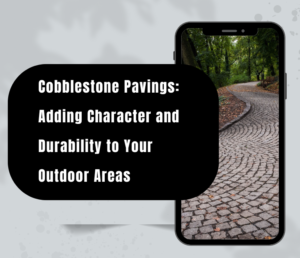Table of the content
- Introduction
- The Timeless Beauty of Cobblestones
- Why Choose Cobblestones for Your Garden Path
- Planning Your Cobblestone Path
- Design Inspiration
- Path Layout
- Materials and Tools
- Preparing Your Garden for Cobblestone Paving
- Laying the Foundation
- Placing the Cobblestones
- Filling the Gaps
- Cobblestone Maintenance
- Enhancing the Aesthetics
- Conclusion
If you’re looking to transform your garden into a charming and picturesque outdoor space, cobblestones are your best friend. Their timeless appeal and rustic elegance can turn an ordinary garden into an enchanting haven. In this guide, we’ll explore why cobblestones are a fantastic choice for your garden path, how to plan and create one, and ways to maintain its beauty. Let’s embark on a journey to create a garden path that exudes character and style.
The Timeless Beauty of Cobblestones
Cobblestones have been used for centuries to pave roads and walkways. Their enduring popularity is due to their rustic charm and longevity. Cobblestones are small, naturally rounded stones that are available in various colors and sizes. They are renowned for their ability to withstand the test of time, making them a perfect choice for your garden.
Why Choose Cobblestones for Your Garden Path
- Aesthetic Appeal: Cobblestones add a touch of old-world charm to your garden. They create a warm and inviting atmosphere that’s hard to achieve with modern materials.
- Durability: Cobblestones are exceptionally durable and can withstand heavy foot traffic. They don’t crack or erode easily, ensuring your garden path remains beautiful for years to come.
- Versatility: These stones come in various sizes, colors, and shapes, allowing you to create a path that suits your garden’s style and your personal taste.
- Low Maintenance: Cobblestones require minimal maintenance. They don’t accumulate water or become slippery, and their natural appearance complements any garden.
Planning Your Cobblestone Path
Design Inspiration
Before you start your project, gather inspiration from various sources. Look at garden design magazines, websites, or even visit local parks to get an idea of the design you want for your cobblestone path. This will help you envision the final result.
Path Layout
Consider the layout of your garden and the path’s purpose. Will it be a straight path, a meandering one, or even a circular path? The layout should complement your garden’s existing features and lead to a focal point, like a garden bench, fountain, or flowerbed.
Materials and Tools
Make a list of the materials and tools you’ll need. You’ll require cobblestones, sand, gravel, a shovel, a wheelbarrow, a level, a compactor, and safety gear.
Preparing Your Garden for Cobblestone Paving
Before you start laying cobblestones, you need to prepare your garden:
- Clear the Path: Remove any existing vegetation or debris from the path area.
- Excavate: Dig a trench to the desired depth for your cobblestones, considering the height of the stones and any additional layers like sand and gravel.
- Create a Solid Base: Add a layer of gravel and compact it well to provide a stable foundation for your cobblestones.
Laying the Foundation
With your path area prepared, it’s time to lay the foundation:
- Add Sand: Spread a layer of sand over the compacted gravel. This will serve as a cushion for your cobblestones.
- Lay the Cobblestones: Carefully place the cobblestones in the desired pattern. You can opt for a uniform design or a more irregular, charming look.
Placing the Cobblestones
When placing the cobblestones:
- Mind the Gaps: Leave small gaps between the cobblestones for drainage. You can fill these gaps with sand or a specially designed filler.
- Use a Level: Ensure the stones are level and firmly seated in the sand.
Filling the Gaps
Once the cobblestones are in place, it’s time to fill the gaps:
- Fill with Sand: Spread sand over the cobblestones and use a broom to sweep it into the gaps. This not only secures the stones but also enhances their appearance.
Cobblestone Maintenance
To keep your cobblestone path looking its best:
- Regular Cleaning: Sweep the path regularly to remove debris and prevent moss or weeds from taking root.
- Weed Control: If weeds appear, remove them promptly.
- Occasional Resanding: Over time, sand may wash away. Add more sand to the gaps as needed.
Enhancing the Aesthetics
To enhance the charm of your cobblestone path:
- Garden Lighting: Install outdoor lighting along the path for a magical ambiance in the evenings.
- Floral Borders: Plant colorful flowers or shrubs along the sides of the path to add a burst of color.
- Garden Decor: Place decorative elements like statues, birdbaths, or garden furniture to create focal points along the path.
Conclusion
Cobblestones have an ageless beauty that can elevate your garden’s aesthetics to new heights. They are not only durable but also create a welcoming atmosphere. With careful planning and maintenance, your cobblestone garden path will be a stunning feature in your outdoor space.
Creating a charming garden path with cobblestones is an investment in timeless elegance that will delight you for years to come.
Enhance your garden with the classic charm of cobblestones. Explore the possibilities today!
FAQ
FAQ 1: Can I use cobblestones for a garden path in a small space?
Yes, cobblestones work well in small gardens. You can choose smaller-sized cobblestones to fit the space.
FAQ 2: How do I prevent weeds from growing between cobblestones?
Regular weeding and applying weed-resistant materials in the gaps can help prevent weed growth.
FAQ 3: Can I install cobblestones myself, or should I hire a professional?
Cobblestone installation can be a DIY project if you have the right tools and skills. However, hiring a professional ensures a polished finish.
FAQ 4: What is the cost of installing a cobblestone garden path?
The cost varies based on the size, design, and materials used, but cobblestone paths are generally cost-effective and durable.
FAQ 5: Do cobblestones get slippery when wet?
Cobblestones have a natural texture that provides good traction even when wet, making them a safe choice for garden paths.



